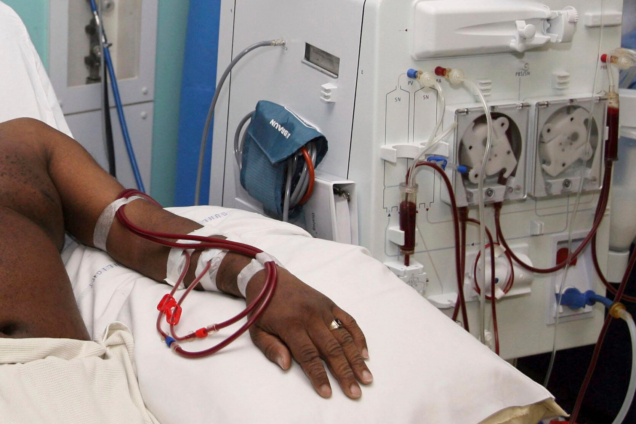In the heart of Ghana, where vibrant culture meets the undeniable pulse of life, a silent crisis has been unfolding. Behind the colourful fabrics, the rhythmic beats of the drums, and the smiles of its people lies a stark reality—a kidney crisis that has gripped the nation.
It all started with a ground-breaking study, "50 years of haemodialysis in Ghana - current status, utilization and cost of dialysis services," authored by Elliot Koranteng Tannor and his dedicated team. The findings in this yet-to-be-published study shed light on the dire situation Ghana faces regarding kidney care.
The numbers!
The research laid bare the cold, hard facts. Ghana has 51 dialysis centres, but only 40 of them are operational. A staggering 65% of these life-saving facilities are concentrated in the bustling Greater Accra region, leaving other regions in the shadows.
The imbalance!
The geographical imbalance is palpable. While Greater Accra basks in the glow of healthcare access, the Ashanti region boasts just 17.5% of the functioning centres. Seven other regions, encompassing nearly 18.5% of the population, have just one centre each.
The machines that matter
Ghana has a total of 299 dialysis machines, with a median of 6 machines per centre. However, this equates to a meagre 9.7 machines per million people. The patient-to-machine ratio is equally concerning, with approximately four patients vying for each machine.
The struggle for survival
Dialysis prevalence stands at 38.8 patients per million population. The numbers differ dramatically between public and private centres, with the former accommodating more patients. Quality of care is at stake, with 57.5% of centres lacking a resident nephrologist. Ghana's nephrologist density is a mere 0.44 per million population, painting a bleak picture for patients in need.
The unreachable dream
In this tale of woe, accessibility is a recurring theme. Seven regions, home to nearly one-fifth of the population, are barren deserts when it comes to dialysis centres. The harsh truth is that 92% of kidney failure patients have no access to dialysis, casting a dark shadow over their chances of survival.
The cost of life
The financial toll of this crisis is severe. The mean dialysis cost per session is $53.9, and patients are forced to choose between public and private centres where costs vary. Public centres offer a glimmer of hope with a lower cost of $48.2 per session, while private facilities charge $56.7.
The absent lifeline
Perhaps the cruellest blow is the absence of government support. The National Health Insurance Scheme, designed to provide a safety net, doesn't cover dialysis costs. This leaves most patients to fend for themselves, forced to bear the heavy burden of paying for their life-sustaining treatments out of pocket.
The race against time
As the sun sets over Ghana's beautiful landscape, the kidney crisis remains a dark and looming shadow. The study by Dr Elliot Koranteng Tannor and his team has exposed the harsh realities faced by the nation's kidney failure patients.
It's a race against time to bridge the gap in accessibility, improve the quality of care, and alleviate the financial burden for those who need it most. Ghana's kidney crisis is no longer silent. It's a rallying cry for change, a plea for help, and a testament to the resilience of a people who refuse to let their nation be defined by this crisis.
Latest Stories
-
Sudanese dropped their guns after AFCON 2025 qualification – Appiah
10 minutes -
BoG Governor, 2 Deputies receive awards at National Hounours Ceremony
10 minutes -
Second Edition of NFL All-Star Game thrills fans at Adringanor Astroturf in Accra
11 minutes -
SEED Elite Camp 2024 inspires Ghanaian youth through basketball and leadership development
16 minutes -
NDC government must consolidate all taxes imposed on us – Ghana Hotels Association
18 minutes -
Kwasi Appiah eyes World Cup 2026 with Sudan
19 minutes -
Bond market: Trading activity falls to GH¢658m post-holiday break
25 minutes -
AFCON 2025: GFA should analyse why Black Stars failed to qualify – Kwasi Appiah
26 minutes -
‘I signed for Sudan because of the war; I believed qualifying for AFCON could end it’ – Kwasi Appiah
38 minutes -
Interest rates to remain elevated; cost of borrowing to continue to be high
38 minutes -
Nhyira FM warms hearts with GH₵230k support for orphanages and needy students
50 minutes -
Students can resit papers in January and February 2025 – WAEC
56 minutes -
22% of banks in Ghana fail to meet CAR threshold of 13% – Report
56 minutes -
Let’s not be arrogant because we’ve won power – Zanetor Rawlings to NDC
1 hour -
Angelina Jolie and Brad Pitt reach divorce deal
2 hours

